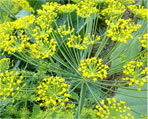



Dill is an annual or biennial herb. It has a smooth surface, finely dissected leave , small yellow flowers and elliptic, flattened fruits. The single stalks grow to a height of I metre.
Dill was known to the ancient Greeks and Romans. Greeks covered their heads with dill leaves to induce sleep. It was also considered a charm against witchcraft in the Middle Ages and was burned to get rid of thunderous clouds and sulphurous fumes.
Dill is native to the Mediteranean region, South Russia and Scandinavia. It has been in cultivation for more than 2,000 years and is now grown widely in Asia Minor, North Africa, India and in all other tropical countries. An analysis of Indian dill shows it to consist of moisture, mineral matter and acid-insoluble ash. The seeds of the plant yield an essential oil known as dill oil. The roots also yield essential oil containing 95 per cent of a-b pinene. The herb yields essential oil with high proportion of terpenes.
Dill leaves are stimulant. They are useful in increasing secretion and discharge of urine and in counteracting spasmodic disorders. They are a soothing medicine and help improve the functioning of the stomach.
Eating cooked dill regularly aids digestion and prevents constipation. The herb is specially useful for children. One or two teaspoons of decoction of the fresh leaves given, mixed with each baby feed-will prevent digestive disorders in babies and help them sleep well. Dill oil, obtained by the distillation of the seeds, is also an effective medicine for hyperacidity, flatulent colic, hiccup and diarrhoea due to indigestion. A drop of dill oil, mixed in a teaspoon of honey, should be licked immediately after meals. Similarly, if a drop of it is administered with castor oil to young children it may prevent griping pain in the abdomen and increase purgative action by relaxing the intestines.
Dill seeds yield a very powerful carminative oil. When these are sauted in ghee with fenugreek seeds in equal numbers, they will serve a specific medicine for diarrhoea and acute bacillary dysentery. For optimum results, roasted seeds are powdered and mixed with curd or buttermilk.
Dill seeds are effective in respiratory disorders like colds, influenza and bronchitis. About 60 grams of infusion of the seeds mixed with honey should be taken thrice daily in such disorders.
Dill is useful in stimulating and regulating menstrual flow. It is effective in spasmodic menstrual pain in young girls and absence of menstruation due to anaemia, exposure to cold and pregnancy. About 60 grams of a decoction of the fresh leaves, mixed with a teaspoon of parsley juice, can be taken thrice daily in the treatment of the .above disorders.
Dill seeds are highly useful in curing bad breath. The seeds are chewed for this purpose.
A paste of fresh dill leaves can be applied as a poultice to ripen blood boils. Its application with a little turmeric powder (haldi) prevents any formation of pus in ulcers and heals them quickly. Leaves boiled in sesame (til) oil makes an excellent liniment for reducing swelling and pain of the joints.
Precautions: Dill leaves are slightly pungent, aromatic and bitter in taste. They should, therefore, be taken only in combination with other mild tasting leafy vegetables.
Pregnancy and Lactation: Dill is of great value to pregnant women and nursing mothers. Its regular use after childbirth increases the quantum of breast milk. It prevents any early ovulation thereby establishing as an effective birth control device.
The fresh green plant is used as a flavouring for soups, sauces and other culinary purposes. The seeds are used as a substitute for caraway seeds and as a source of dill-water, especially for relieving flatulence in babies. The leaves can serve as supplement to vegetable salads. The leaves and seeds can be used in making pickles or chutneys and summer beverages.
Copyright © Krishna Herbal Company 2022. All Rights Reserved Powered By: Planet Ayurveda







